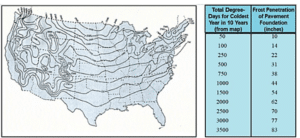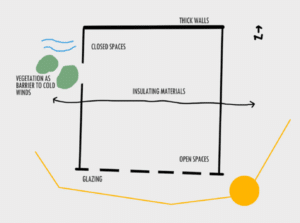

There are several factors that a Civil Engineer must consider during the planning stages of a project. One of the most crucial factors an engineer must take into consideration in any design is the location of the project and that location’s climate. In geographical areas that experience all four seasons, an engineer’s designs must be able to safely withstand both scorching-hot summers and freezing-cold winters. In the wintertime, engineering for freezing temperatures, snow and ice can be challenging. There are additional factors to consider in cold climates while engineering foundations, roadways, pipes and so on.
What particular measures do engineers take to avoid cold-weather complications in their project designs?

Frost Lines, Ground Temperatures and Preventing Frost Heave
When designing foundations, roadways, roofs, and other structures in cold-weather climates, an important factor an engineer must consider is the frost line. The frost line is the depth at which the ground is expected to freeze during the coldest part of the year.
In very cold regions, the frost line can be quite deep – often several feet below the surface. This can affect the design of foundations, as the foundation must be deep enough to be below the frost line to prevent damage from frost heave. In the case of frost heave, the expansion of frozen water in the soil pushes the ground higher, which can damage foundations, roadways and other structures.

To prevent frost heave, civil engineers may design foundations with deep footings or use other techniques, such as insulation or heating, to keep the ground below the frost line from freezing. They will also consider the average ground temperature in the region, as this may modify the frost line and increase the possibility of frost heave.
Designing Roads and Structures with Snow and Ice in Mind
In addition to foundations, civil engineers must also consider the effects of freezing temperatures on roadways and roofs. Bridges in cold weather regions must be designed to withstand the weight of snow and ice, and roadways must endure the effects of salt and other de-icing chemicals.
Salt can be damaging to roads, as it can corrode the asphalt and weaken the structure over time. As a result, civil engineers may use special materials or treatments to protect the roads from the effects of salt.
The contour of the road can also play a role in the drainage of snow and ice. In hilly or mountainous regions, roads may be designed with a crown, or a slight slope from the center to the sides, to allow for better drainage of snow and water. Additionally, civil engineers may design culverts to allow for the proper drainage of melting snow and ice.
On roofs, civil engineers must consider the effects of heavy snowfall and ice dams. Ice dams can form when melting snow refreezes at the edge of the roof. To prevent damage from ice dams, civil engineers may design roofs with a steep slope, or use unique materials or techniques, such as insulation and ventilation, to prevent the formation of ice dams.
Choosing the Proper Materials to Withstand Cold Weather Complications
In cold-weather climates, it is particularly important to choose the proper materials for the construction of foundations, roadways, roofs, and other structures. For example, concrete is a popular choice for foundations and roadways because it is strong and durable, and it can withstand the expansion and contraction caused by changes in temperature. However, concrete can be prone to cracking in cold weather regions. To prevent cracking in concrete, engineers may implement special techniques like adding reinforcing bars or an air-entraining agent to the concrete. Air-entraining agents create microscopic bubbles in concrete, making the concrete more durable when faced with the expansion and contraction caused by extreme temperature changes.
Another factor to consider is the impact of snow and ice on the structure. In regions with heavy snowfall, it is important to design structures that can withstand the weight of the snow. This can involve using stronger materials, such as steel or reinforced concrete, or designing the structure with additional support.
Additionally, civil engineers in cold climates must consider the impact of ice on the structure, such as the formation of ice dams on roofs or the accumulation of ice on roadways. To prevent damage from ice, materials that retain or generate heat may be implemented throughout portions of the structure to prevent ice damage.
Natural Landscape & Surrounding Environment
In mountainous or hilly regions, the slope of the land must be factored in when designing foundations, roadways, and other structures. For example, a roadway built on a steep slope may require additional support or reinforcement to prevent landslides or erosion. A project’s natural landscape may also make it more challenges for proper drainage of ice & snow. It’s important that a solution is designed to ensure that ice & snow can melt and be displaced appropriately.
If a project is to be implemented in an area near bodies of water or other sources of moisture, this can impact the proposed design. Moisture can cause damage to a structure and increase the risk of frost heave.
Minimizing Energy Loss & Maximizing Effects of Natural Heat Sources
In colder regions, an engineer must also be mindful of energy consumption. Their designs should include strategies that reduce energy consumption and maximize the benefits of natural resources.
When planning a project, an engineer must pay special attention to a structure’s wall area, window area, thermal insulation, and thermal mass. Thermal mass is the ability for a structure or material to absorb, retain and release heat.
When engineering for freezing temperatures, a structure should be designed to maximize heat absorption and retention. For example, the sun is a great source of natural energy, and an engineer may configure a design to maximize the effects of the sun to off-set the complications of cold winds, freezing weather conditions and heat loss. Of course, this idea can become more complicated when designing for regions that experience all four seasons.

Engineering Structures & Roadways for the “Long Haul”
Finally, civil engineers must consider the long-term maintenance and durability of the structure when engineering for freezing temperatures. This can include designing the structure with materials resistant to corrosion, erosion, or deterioration or using special techniques such as sealing and waterproofing to protect the structure from the elements. The impact of temperature changes on the structure over time can also be significant and require life-long maintenance. The continued expansion and contraction of materials can be damaging, even with the proper materials, and should be monitored and re-evaluated to ensure it can be operated safely. The contraction of concrete can result in the formation of cracks. If water enters the cracks during cold weather, it can freeze. When water freezes, it expands, which can then widen the gap. Proper steel reinforming will minimize the amount of cracking that can occur.
In (Cold Climate) Conclusion…
Engineering for freezing temperatures in colder regions requires careful consideration of a wide range of factors including: the location’s frost line, the average ground temperature, the effects of salt and other de-icing chemicals, the contour of the road, the risk of ice dams, the types of materials used, the impact of snow and ice, the project’s natural landscape, and the long-term maintenance and durability of the structure. By considering these factors, civil engineers can design foundations, roadways, roofs, and other structures to safely and efficiently withstand the harsh conditions of cold weather regions.
How Can Carroll Engineering Help Your Next Project?
As a professional engineering firm that services the Greater Philadelphia Area, and New Jersey we are well-versed in designing projects to withstand record-setting low and high temperatures. Carroll Engineering delivers highly regarded professional services including water facilities engineering, wastewater engineering, structural engineering, and planning & site design services to a wide range of authority, municipal, public and private clients.
We have offices located in Warrington (Bucks County, PA), King of Prussia (Montgomery County, PA), Malvern (Chester County, PA), as well as our New Jersey office in Hillsborough (Somerset County). Cold weather complications can be challenging to combat – luckily, we are experts at engineering for freezing temperatures! We’d love to design a solution for you that will last many winters to come.
If you have any questions or would like to discuss a project, please contact John Koutsouros P.E., Planning & Site Design Department Manager at jkoutsouros@carrollengineering.com (215) 268-3808, or Mike Traczuk P.E. Structural Engineer at mtraczuk@carrollengineering.com (215) 543-6772.
